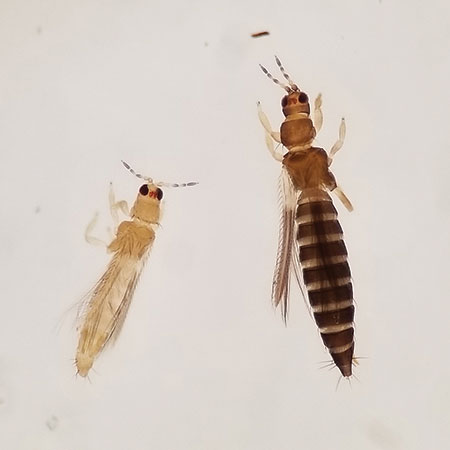6/30/2025
AFE-Funded Research Helps Growers Profit
Julie Martens Forney

Every grower knows that it takes at least three things to survive in the horticulture industry: hard work, risk and innovation. The balance and priority of those items varies over time, but each is key to continued success.
And success is within reach, considering that the ornamental live goods category has been in a growth mode, inching up by 1% each year since 2020, when the pandemic gardening boom exploded. Grabbing part of that growth relies on fine-tuning the fundamentals of growing while controlling everything you can in the production process. That’s the ultimate secret for floriculture success and it becomes easier when you team up with the American Floral Endowment (AFE).
AFE funded research on DIF in 1984, which is now standard operating procedure in greenhouses across the country. Image by Dr. Royal Heins.
With 63 years in the rear-view mirror, and over $20 million in funding for research and education, AFE knows the industry—its practices, people and potential pitfalls. The Endowment has been around long enough to have helped define and refine crop growth practices, pest and disease control strategies, and cool chain management protocols. AFE has supported the industry since the 1970s, when energy conservation, solar energy conversion and lighting innovations were first taking shape in greenhouses.
Today the research may focus on cutting-edge gene editing to confer disease resistance or identifying bacteria that promote rooting in potting media. But the end result remains the same: AFE is committed to building and supporting a successful floral industry.
University research: A vital priority
One of the things that makes the Endowment so impactful in the industry is its partnership with growers, which enables AFE to identify and tackle problems as they arise. A great case in point is the identification and control of tomato spotted wilt virus (TSWV). This disease surfaced in the greenhouse industry 40-plus years ago, and the Endowment pivoted to dedicate funding so university researchers could determine how the virus moved and what steps growers could take to control it. Research efforts on TSWV continued through the early 2000s, as university researchers hustled to investigate control systems for the virus vectors.
 It’s not just pest or disease threats that have put the Endowment on the front lines for growers. The organization has also helped fund development of cultural practices through university research—the same practices you probably use today to save time and inputs.
It’s not just pest or disease threats that have put the Endowment on the front lines for growers. The organization has also helped fund development of cultural practices through university research—the same practices you probably use today to save time and inputs.
The 1980s brought advances in avoiding heat delay in potted chrysanthemums and also optimizing the greenhouse environment to enhance plant growth while reducing stem elongation (DIF). That university work was groundbreaking at the time. Today, it’s standard operating procedure in greenhouses across the country. You may even use it with no clue that AFE helped fund the university research behind it.
AFE is currently funding research for the management of the new invasive pest Thrips parvispinus. Results from the first year will be released to the industry this year. Image by Dr. Rose Buitenhuis and Dr. Sarah Jandricic.
That’s the kind of work AFE does. Why? Because sustaining university programs is crucial to industry innovation and success. If you doubt that, consider the fact that many graduate students who’ve received research funding through the Endowment are now professors who continue to pursue breakthrough projects to keep production competitive in the 21st century. AFE is a full-circle operation, helping to nurture young researchers who’ll go on to become leading voices in the industry.
Research protects your business
By funding targeted studies, AFE is able to create an impact on how you do business—an impact that saves money, drives efficiency and, ultimately, propels profits, all while ensuring industry advancement. Here are just a few ways Endowment-funded research helps your business thrive:
Biocontrols & biorationals
With today’s value-driven, eco-conscious consumer, producing high-quality plants with the fewest chemical inputs is mandatory. Reducing conventional pesticide applications also helps prevent resistance issues and navigates the shrinking availability of these highly regulated products. AFE is committed to helping growers address pest and disease problems—both on the bench and off—using reduced risk strategies, including cutting edge plant-incorporated protectorants.
Endowment-funded research has helped with controlling thrips, whiteflies, powdery and downy mildews, Ralstonia, Pythium, and many more pests and diseases. What’s currently in the research pipeline?
- Mitigation of the invasive tropical pest, Thrips parvispinus: Clean start and biological control. Rose Buitenhuis and Sarah Jandricic are researching sustainable long-term solutions for management of Thrips parvispinus in greenhouse ornamentals. Taking a systems approach, the project will investigate several IPM strategies that may be combined to provide optimal control of T. parvispinus.
- Enhancing the performance of biological control agents for Botrytis control: At Clemson University, Jim Faust and Guido Schnabel are continuing to unravel the mystery of why biological control agents for Botrytis blight often perform well in the lab, but fail in the greenhouse. By determining why this happens, they hope to discover conditions that will help these biocontrols survive and succeed as disease management tools in the greenhouse.
Production technology
Efficient production helps drive greenhouse profits. By funding university research that includes automating irrigation using substrate moisture sensors, optimizing lighting systems to improve energy efficiency and flower quality, and enhancing the postharvest life of unrooted cuttings during shipping and storage, the Endowment has helped growers improve crop consistency and quality, while reducing inputs like water, energy and labor. What’s currently in the research pipeline?
- Developing foliage stock plant, liner and finish plant production protocols for temperate climates: Michigan State University’s Roberto Lopez is quantifying how daily light integral, air and root-zone temperatures, and PGRs interact to affect foliage stock plant cutting yield and rooting. He’s also modeling how temperature influences leaf unfolding rates.
- Putting floriculture AI to work—Development of smart diagnostic tools: Brian Whipker at North Carolina State University is working to enhance diagnostic accuracy for floriculture nutrition by expanding leaf tissue standards and developing an AI-driven algorithm and web-based app that provides automated interpretations and recommendations for poinsettias, geraniums, New Guinea impatiens, petunias and gerberas.
Substrates & sustainability
With peat moss under increasing environmental and regulatory pressure, AFE has funded university research projects to help identify locally available and renewable alternatives, such as pine chips, biochar and wood fiber.
The organization has also supported research examining the impact of these different growing substrates on nutrient availability, water uptake, disease suppression and overall plant performance. What research is underway right now?
- Floriculture production practices in peat-reduced substrates: At NC State University, Brian Jackson is generating data on crop management strategies using economical and sustainable peat alternatives. His results offer immediate application for growers who can implement them to improve production efficiency, reduce crop loss and improve crop quality.
- Reducing peat-use in greenhouse production through wood fiber substrate stratification: The University of Florida’s Jeb Fields is exploring stratified substrate systems for greenhouse production using wood fiber and other low-cost filler materials. The work also examines irrigation and fertility in stratified-grown crops to strengthen understanding of how these materials work in container production.
When you support AFE, you’re supporting university research that’s industry-driven because it’s industry-funded. It’s a way to invest in the future and drive the innovation that shapes industry practices. Ultimately, every dollar you invest in AFE delivers tangible results for your business.
The research shared here today is just a fraction of what AFE funds. To learn more about the Endowment, the research it supports and the results of decades of university research presented in easy-to-understand formats, visit endowment.org. GT
Julie Martens Forney is a freelance writer with more than 25 years of experience writing about floriculture industry issues and gardening for consumers.